5 Signs that Address the Ford V10 Problems: 2023 Detailed Guide
If you want to buy a vehicle with a Triton V10, you should look for Ford V10 problems such as flawed spark plugs, exhaust and fluid leaks, and poor fuel economy.
Hence in this article, we will discuss common issues that drivers report, their solutions, and which models you should avoid. Additionally, we will weigh the specs, pros, and cons of different manufacturing years, and share tips to prolong its life. Let’s begin!
Table of Contents
Ford Triton – Merits and Demerits
Ford Triton V10 engine has its merits and demerits. Drivers have given mixed reviews, and their experiences have differed. This is due to various year models and upkeeping. Read below what the majority opinions say.
Strengths
You can trust engines in Ford trucks because:
- Triton V10 has a great torque output.
- These are capable of towing heavy loads.
- Its parts and services are easily available.
- They are durable and reliable if regular maintenance is promised.
- More fuel efficient than diesel engines for short trips and lighter loads.
Weaknesses
There have been a couple of unsatisfied customers. They have issues such as:
- Poor fuel economy.
- Problems with spark plugs, exhaust leaks, and fluid leaks with high maintenance costs.
- Comparatively has less power than diesel engines for heavy loads or long routes.
Ford V10 Triton Specs
Let’s have a look at the specifications of the Ford V10 so you can understand what to expect in terms of its performance. Have a look:
Specs | Ford V10 Triton |
Photo: |  |
Engine: | 90-degree V10 |
Engine Family: | Ford's modular engine family (Triton) |
Displacement: | 6.8 litre |
Horsepower: | 305hp (1999), 310hp (2000-2004 models), 362hp (2005 models and onwards) |
Torque: | 420lb-ft (1999), 425lb-ft (2000-2004 models), 457lb-ft (2005 models and onwards) |
RPM’s: | Max 5,200 |
Block: | Cast iron engine block |
Spark plug: | Centrally mounted spark plugs |
Compression: | 9.2:1 |
Bore x Stroke: | 3.552 x 4.165 inch (90.2 x 105.8mm) |
Valvetrain: | Single overhead cam with 2-valve (1999- 2004 models), 3-valve (2005 and onwards models) |
Lifters: | Hydraulic roller |
Head: | Aluminum |
Firing Order: | 1-6-5-10-2-7-3-8-4-9 |
Oil Capacity: | 7 quarts |
Weight : | 625 lbs. |
Ford V10 Problems: Engine Drivers Report
You now understand what the engine can offer and its capabilities. Let’s delve into the problems you can face. It is essential to know because issues can arise in even the best engines. Especially if used for a long time without maintenance.
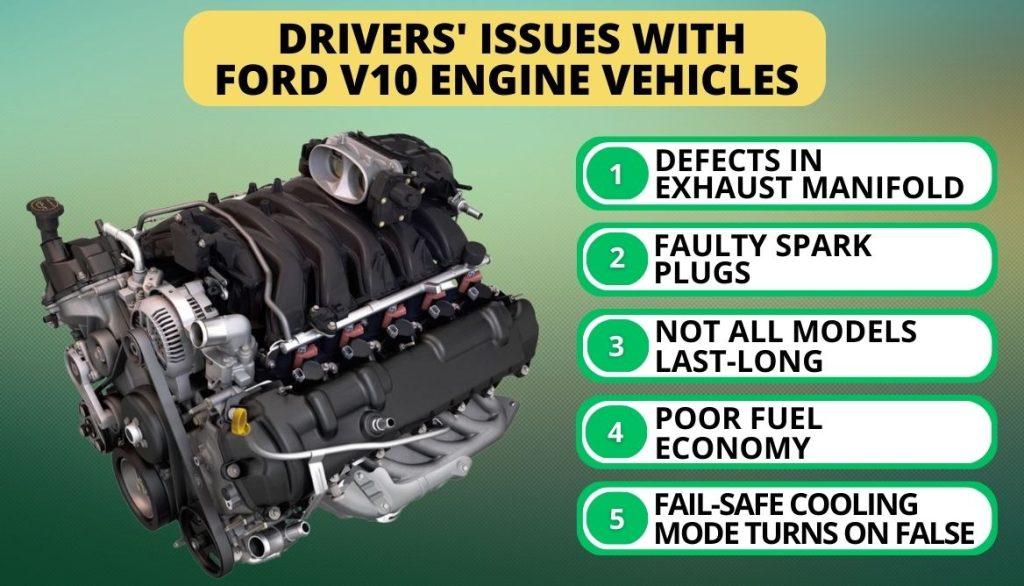
1. Defects in Exhaust Manifold
The Ford V10 engine is known for its faulty exhaust manifold, primarily caused by rust. The likelihood of this issue occurring may vary on the climate of the driving location. Areas with high humidity levels with salty air are more at risk of this.
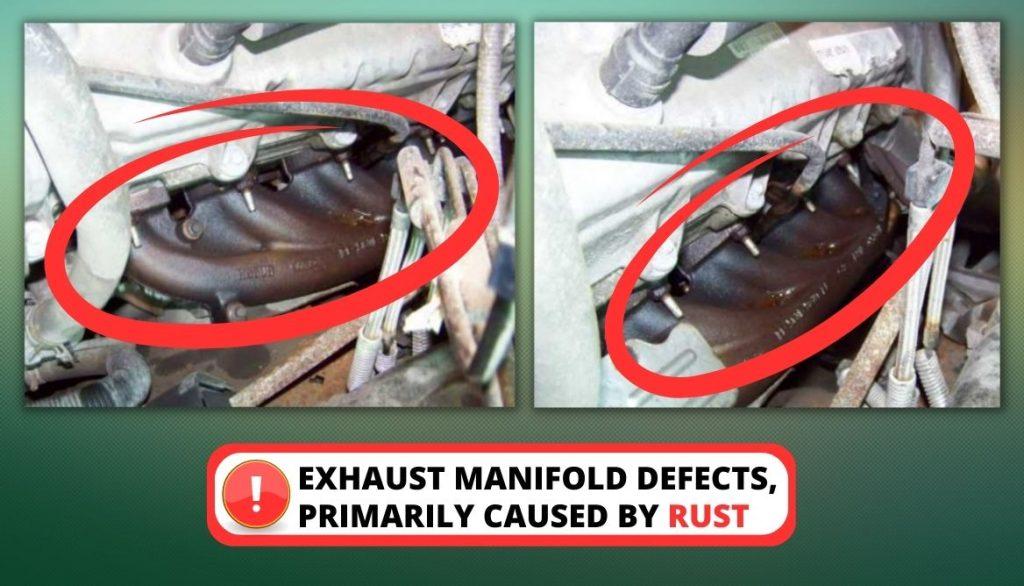
Exhaust Leak
Its failure may result in an exhaust leak. This happens because small bolts loosen and fall when you are driving. Seemingly it is not a significant problem but these can lead to:
- Fuel inefficiency,
- Sensor failures,
- Increased pollution.
Caution: The fumes leaking into the cabin are a serious concern if the exhaust manifold can’t contain them. This poses a significant health hazard that must be addressed promptly.
Seep Fluids
Aside from exhaust bolts falling, fluids can also seep out if there are cracks in the manifold. In this scenario, you will need to replace it. The symptoms of leakage are:
- Noisy exhaust system.
- Bad fuel economy
- Poor acceleration
- A smell coming out of the exhaust manifold
2. Faulty Spark Plugs
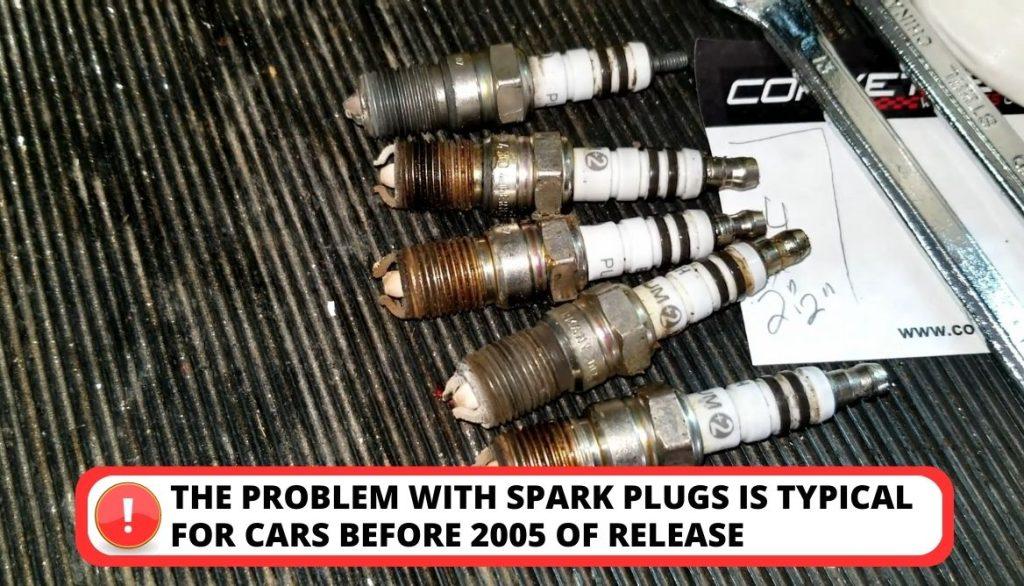
Spark plug problems reported in older models of Ford vehicles built before 2005 include:
- It pops out of place.
- Ends up stripping its threads.
The causes of these matters could be:
- It is now old or expired.
- Ash deposits have accumulated on the spark plug tip.
- Fuel and carbon fouling is causing the failure.
Note: The spark plug issues are relatively uncommon in newer engines. It is not exclusive to the Ford V10 engine and is prevalent in other Ford engines, such as the 5.4 L engine.
Remember: To ensure optimal performance, it is important to use the correct torque and anti-seize when replacing the spark plug in a Ford V10 engine.
3. Not all Models Last-long
The 6.8 Triton V10 is generally considered to be reliable and a good engine. Internal components usually do not cause any major issues before reaching the 200,000-mile mark. These include:
- Piston rings
- Valves
- Camshafts
- Connecting rods
- Bearings
The only exception is the spark plug problems which can be prevented with a repair kit that costs a few hundred dollars.
Maintenance Details after 200,000 miles
After driving for 200,000 miles maintenance-related repairs to the following are required which aren’t very costly:
- Water pumps
- Fuel pumps
- Hoses
- Gaskets
Note: If the 6.8 Triton is used in big motorhomes or for heavy hauling, problems are more likely to occur earlier in the engine’s life due to the additional stress put on it by the weight.
4. Poor Fuel Economy
The fuel consumption of the V10 engine is the weakest aspect of this engine:
- It is considerably high, making it burdensome in terms of efficiency. Also, the issue with the fuel pump can lead to a bad fuel average.
- Its city fuel economy averages 9-10 miles per gallon (MPG).
- Highway fuel economy ranges between 12-14 MPG.
- In comparison to diesel engines, the V10 engine’s efficiency is relatively low and costs much more because of premium fuel.
5. Fail-Safe Cooling Mode Turns On Unnecessarily
Some recreational Ford trucks and RV owners have reported issues with the engine cooling system going into fail-safe mode, even under a slight load. This can be inconvenient, as it limits power output to some cylinder heads to prevent further damage.
Fail-Safe Mode Activation
If this happens frequently, it will cause difficulties to run the engine at full power. The fail-safe mode is activated by the following.
- The Engine Coolant Temperature sensor
- The Cylinder Head Temperature sensor.
If either of these detects temperatures around 140 degrees Celsius, the circuit will activate the fail-safe mode, restricting the engine’s performance. It’s possible that these sensors are faulty, resulting in the system triggering the mode unnecessarily.
Are the Ford V10 Engines Dependable?
The longevity of any vehicle is contingent upon the quality and consistency of its maintenance. This is true for the Ford Triton V10 engine as well. It is generally reliable but can be prone to issues without proper care.

A Spark plug problem can arise in 2002 and older models however Triton V10 can exceed 200,000 miles. We say with confidence as Doug DeMuro states that there are multiple examples existing that have crossed it. One individual even passed 300,000 miles
Can One Rely on Ford V10 Engine’s Durability?
In short, Yes! The Ford V10 engine has been known for its reliability and consistent power output for almost two decades. It has been the preferred engine for many work trucks which is enough evidence of its robustness as their livelihood depends on it.
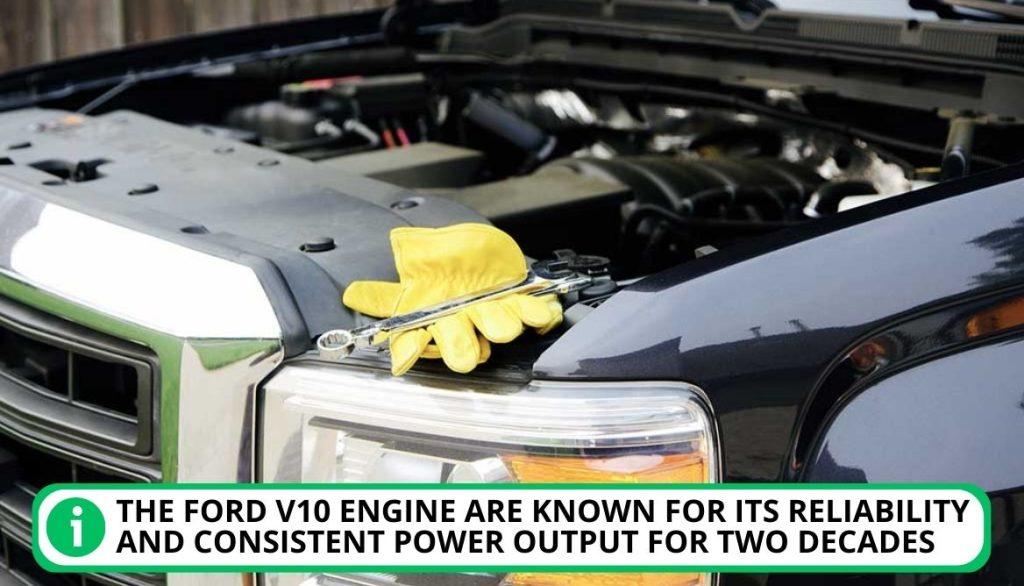
Many drivers would attest to its incredible power and torque. The company itself trusts this engine with many industrial-strength vehicles proving its durability.
Ford V10 Model Years You Should Not Invest In
Triton V10 is a powerful engine and is well-loved by vehicle owners. It did earn a bad reputation briefly because of the models Ford released before 2002. Let’s look at each year’s performance individually to determine which ones you should not invest in.
Pre-2000 Models
The Ford Triton V10 engine has been known to have troubles with its spark plug. It plays a critical role in igniting the combustion to start the vehicle. Unfortunately, in the pre-2000 models,
- The spark plug had a tendency to eject itself, leading to an immediate loss of power.
- At high temperatures at which the engine operates, the spark plug may also begin to melt.
This issue can be a significant source of frustration for vehicle owners. These models are not recommended to use.
Ford V10 Model Year 2000
The models prior to the year 2000 had issues but additional problems came were introduced when the 2000 version arrived. Let’s read what these are.
Fuel Economy
The engine had terrible fuel economy, which drew complaints from many buyers. It features 10 cylinders and requires premium fuel, resulting in higher fuel costs and reduced efficiency.
Weak Studs and Bolts
Owners also reported issues with the exhaust bolts frequently breaking, necessitating frequent replacements. This issue can result in increased repair costs and reduced performance.
Ford V10 Model Year 2001
The 2001 model of the Ford V10 engine showed some improvements compared to the previous versions, but it still had some issues that affected its performance. Consumers have reported issues with:
- Engine’s fuel efficiency
- High cost of repair when problems do arise.
- Gear-shifting problems when driving uphills.
Ford V10 Model Year 2003
The V10 models produced after 2002 underwent significant updates. It included the implementation of 3 valves per cylinder, resulting in higher performance of power and torque.
However, there are issues that arose in the newer V10 models:
- The Positive Crankcase (PCV valve hose): It is connected from the engine to the intake system. It was prone to cracking or breaking over time, leading to leaks.
- Manifold’s studs: These would corrode and break. Hence, drivers complained about exhaust leaks, which could end up in the passenger compartment.
Ford V10 Model Year 2017
The introduction of newer models in 2017 saw a shift in this trend. Numerous drivers reported:
- Misfires on the cylinders were caused by a loss in compression.
- A new problem surfaced in the form of gear-shifting issues resulting from faulty computer connections.
In particular, the automatic transmission had difficulties shifting when the vacuum seal was compromised or when the connections were not properly tightened. To avoid such issues, it is essential to ensure that all computer connections are regularly inspected and maintained.
Additional Problems of Ford V10 Engines That May Arise
We want to fully prepare you for the possible problems. Hence we have compiled a list of other issues that can happen. You must read to avoid damage to engines.
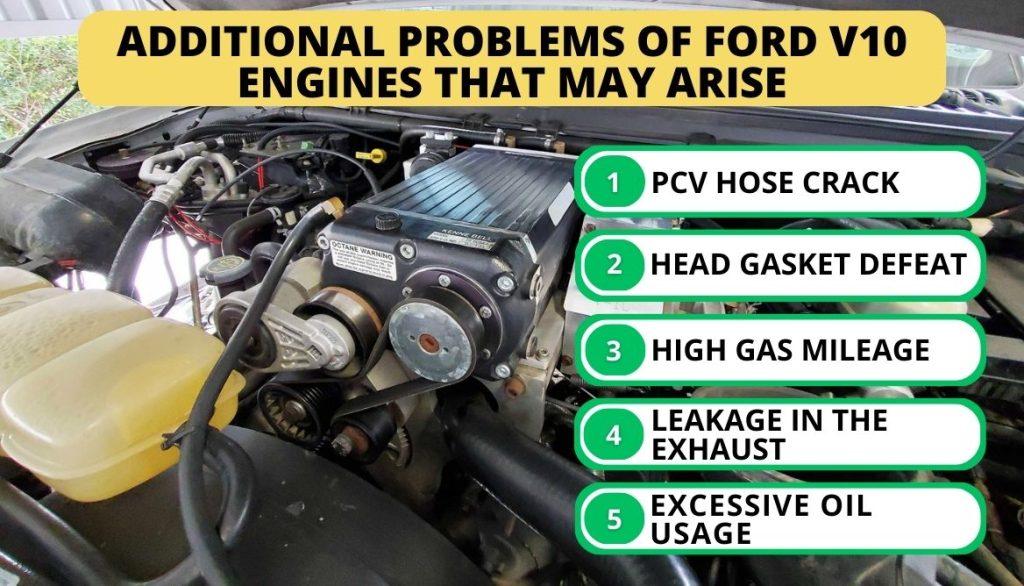
1. PCV Hose Crack
The Positive Crankcase Ventilation (PCV) valve hose in the Ford V10 had a recurring issue of cracking and sometimes breaking, causing rough idle and combustion issues. This was a common problem reported by drivers, and it affected the engine’s performance and reliability.
2. Head Gasket Defeat
Head gasket failure is a significant problem that can lead to various issues in the engine, such as burning excessive amounts of oil and emitting a foul smell.
This problem is usually caused by a leaky coolant passage. The combustion gases can pressurize it, resulting in reduced levels and impaired engine functioning.
3. High Gas Mileage
The Ford V10 engine is known for its bad fuel efficiency due to its large design:
- It only offers between 7 and 10 miles per gallon (MPG).
- This issue becomes worse after the engine reaches 100,000 miles due to multiple problems.
- This makes it less competitive in today’s market where there are cheaper engines with better gas mileage available.
- Some buyers may add third-party tuning chips to improve fuel economy.
However, we recommend going for other vehicles if MPG is a priority.
4. Leakage in the Exhaust
We discussed above the leakage in detail. Since this issue happens often we wanted to help you further. Watch this video in order to learn in-depth about why this occurs and how to fix it.
5. Excessive Oil Usage
The V10 engines tend to consume approximately one quart of oil per every 1000 miles driven.
- If there are worn-out components in the engine, it may result in increased oil consumption.
- Additionally, if the engine has not been used for an extended period, the synthetic oils may evaporate, leading to greater oil loss.
- This means more frequent engine maintenance is required for the V10 compared to other 4×4 vehicles.
Simple Practices to Help a V10 Ford engine last longer
Every engine has its upsides and downsides but its life expectancy also relies on how the owners treat it. A well-kept engine will provide you with decent power for a long time while lack of maintenance can shave off years from the same model.
Read below the handful of tips you should remember to extend the life of your engine.

1. Drive Responsibly
The Ford V10 engine is not intended for high-speed driving.
- Going aggressively may result in significant wear and tear, leading to the need for repairs.
- If driven gently and steadily you can achieve better fuel efficiency.
- Practicing smooth driving habits can lead to an engine that lasts for more than 200,000 miles
2. Regular Maintenance and Inspection
Timely vehicle maintenance is essential for ensuring the longevity of any engine. Hence consistently replace the oil and transmission fluid. By performing routine upkeep at recommended mileage intervals, you can:
- Detect and fix minor issues before they escalate into significant problems.
- Save you a considerable amount of money in the long term.
3. Do Not Overlook Alerts and Gauges
Here’s what you need to understand:
- Each indicator and warning in a vehicle serves a specific purpose, whether it’s to remind the driver to lock a door properly or to signal low fuel levels.
- While the V10 is great for heavy-duty towing, ignoring alerts, especially those related to engine temperature, can pose a significant safety risk.
Note: Some indicators are more critical and signify serious issues that require immediate attention.
4. Modifying Alot Will Not Help
Making modifications to the Ford V10 can certainly improve its performance. However, it’s essential to understand that these modifications can also reduce its reliability and lifespan.
FAQ
Is the Ford V10 a reliable engine?
The Ford V10 is a reliable engine. Internal components usually do not cause any major issues before reaching the 200,000-mile mark. However, problems with Spark plugs have been noted.
What years did Ford V10 have spark plug issues?
Spark plug issues were seen in the years 1999 to 2005 Ford V10.
Why did they stop making V10?
V10 making was stopped because the performance of V6 and V8 was enhanced due to turbos and new engine architecture.
What are common problems with a Ford V10?
Common problems with a Ford V10 are leakage from the exhaust, disappointing fuel efficiency, and faulty spark plugs.
Why are V10 engines rare?
V10 engines are because they are in comparison harder to make than V12 and more expensive than V8.
Conclusion
Ford Triton V10 is a powerful engine, that heavy vehicles can rely on. It can last over 200,000 miles if properly maintained and driven smoothly. On the other hand, there have been many problematic models in which you should not invest.
The pre-2000 had problems such as spark plug ejecting or melting due to heat. The models of 2000 to 2005 would have cracks in the PCV hose and unreliable gas mileage. The later years had gear-shifting issues but many drivers do not mind them.
We recommend you invest in the latest ones and keep an expert attached for regular upkeep. Which model have you set your eyes on? Do share with us in the comments.

I`m a current Law Enforcement Officer working within the Counterterrorism Bureau in New York State. I have been Camping for over 20 years. My styles of camping include tent, car, truck, van, and RV travel trailer. I have a YouTube channel where I teach all types of camping with an entertaining method: https://youtube.com/@TheSmallsRVAdventures






